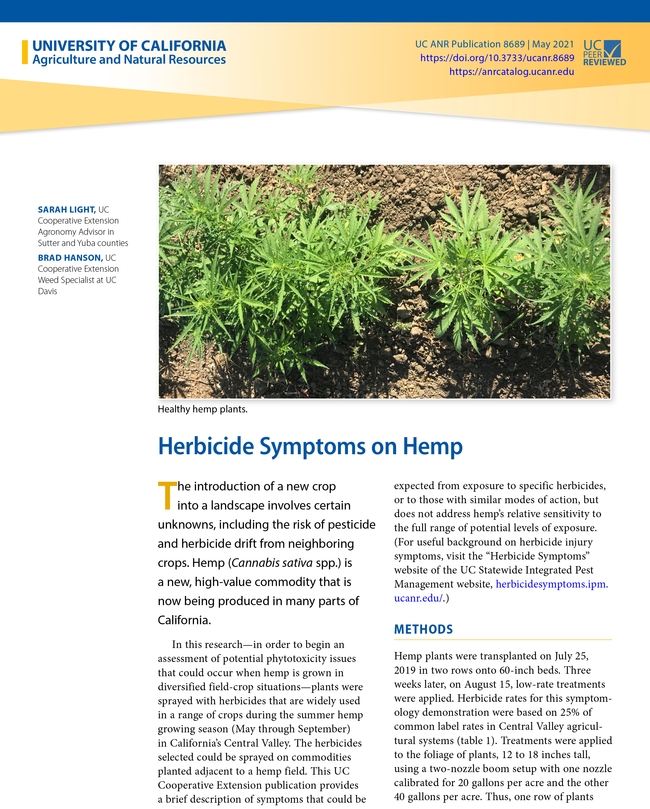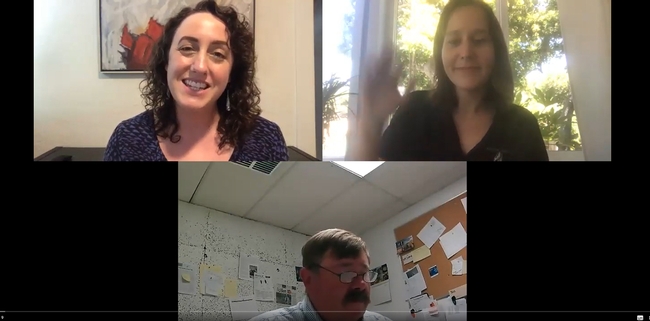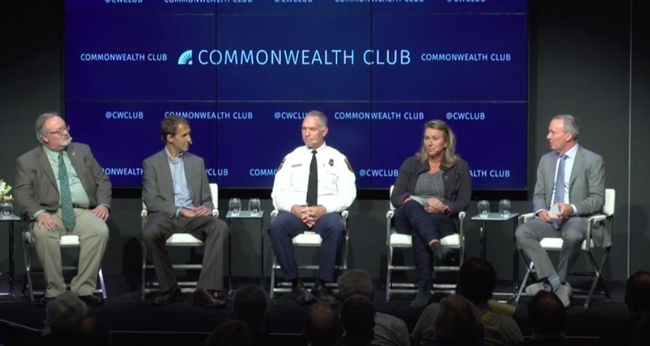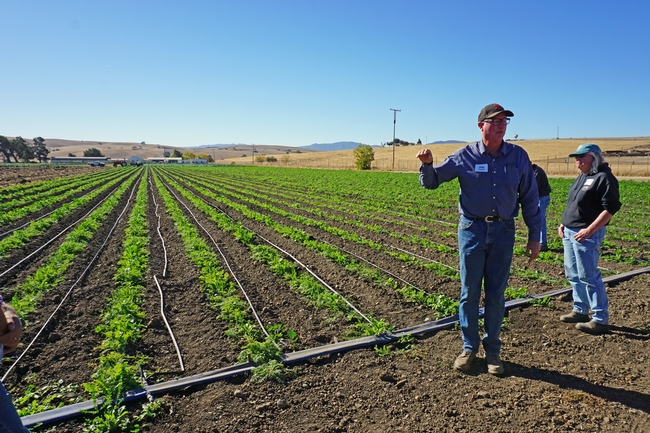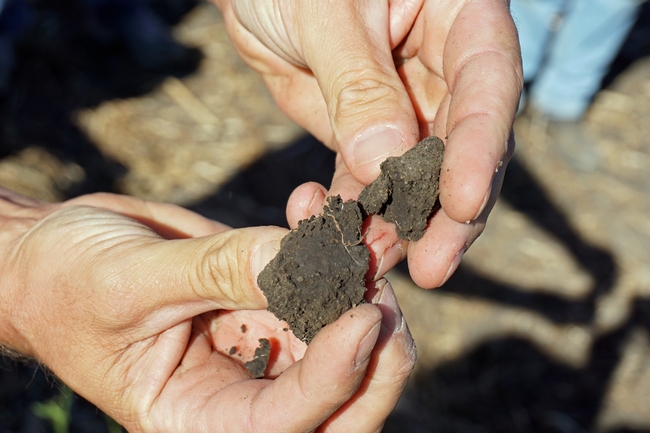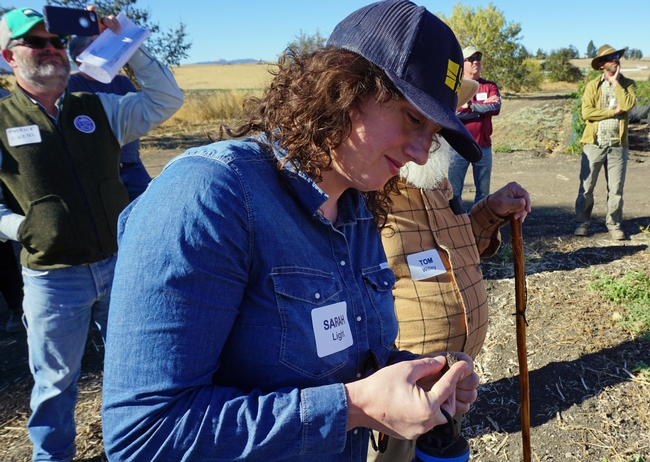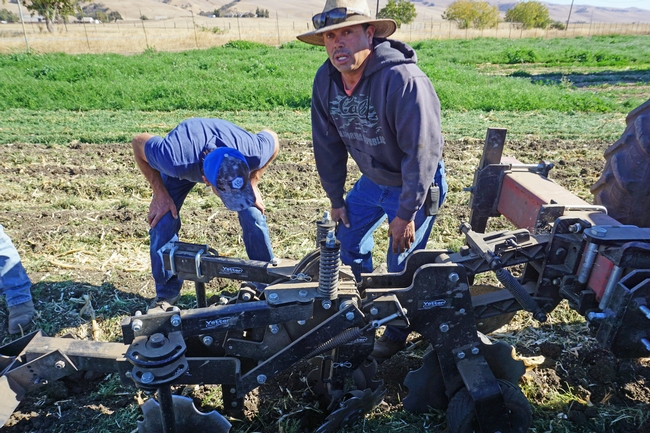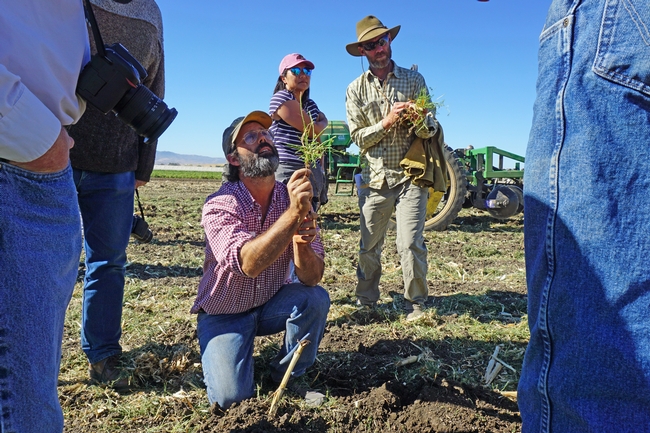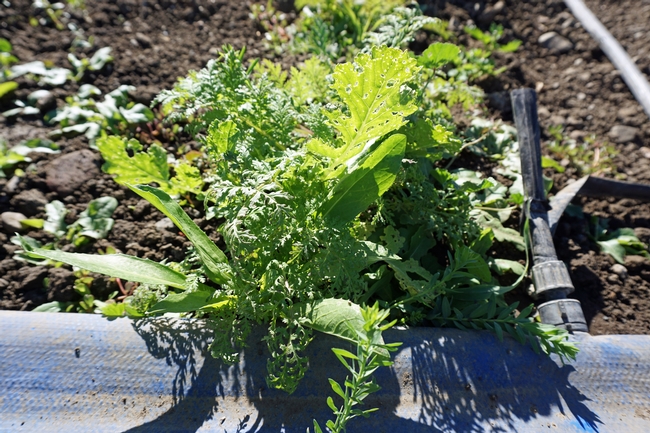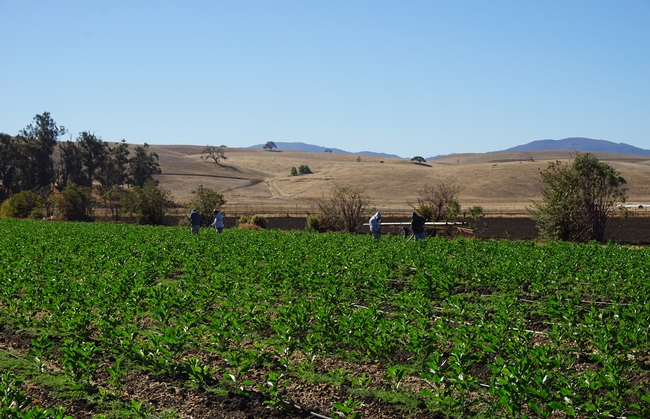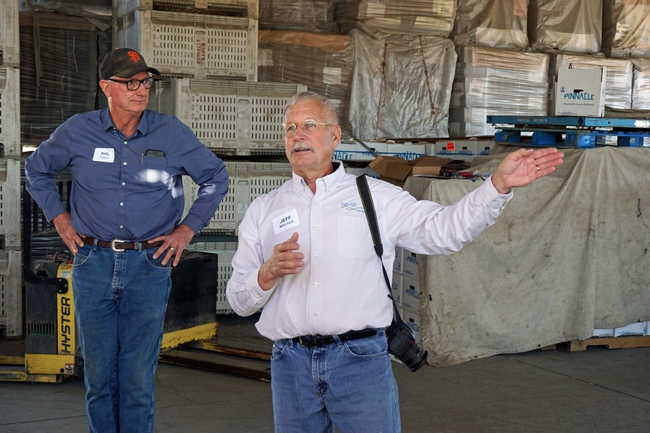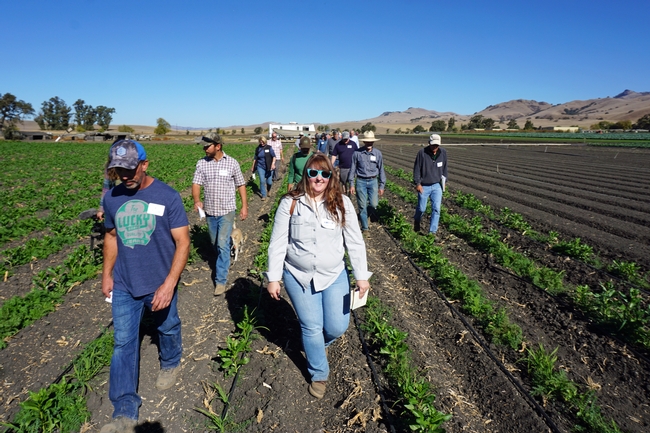Posts Tagged: Sarah Light
New UC hemp publication shows potential symptoms caused by herbicide drift
Adding to a growing body of research about hemp cultivation, UC Cooperative Extension advisor Sarah Light and UCCE weed specialist Brad Hanson studied the symptoms of herbicide drift on this high-value commodity that is now being produced in many parts of California.
The results are available in a free downloadable publication in the UC Agriculture and Natural Resources catalog at https://anrcatalog.ucanr.edu/Details.aspx?itemNo=8689.
Hemp was legalized for production nationwide in the United States under the 2018 Farm Bill. Hemp has many uses – from textiles to food to biofuel – however is most sought-after for the chemical component cannabidiol (CBD), extracted for medicinal use.
Because of hemp's recent entry into the California crop complex, growers are hungry for information that will help them make irrigation, fertilization, pest management and other decisions.
“When they see unexpected damage on the plants, our growers, county agricultural commissioners and pest control advisers need to be able to determine whether a crop might have been subjected to herbicide drift from an adjacent field or orchard,” Light said. “We provided science-based evidence that can help guide their judgement.”
The scientists exposed hemp to low rates of 19 herbicides used in California. The rates and spray coverages are higher than would commonly occur in herbicide drift situations, because the scientists sought to compare typical symptoms from several herbicide modes of action on hemp. The publication contains 25 color photographs demonstrating the notable symptoms of different herbicides. In addition, detailed explanations about the symptoms observed over a two-week period following exposure are provided.
UC Cooperative Extension and Colusa RCD launch 'Soil Health Connection'
University of California Cooperative Extension and the Colusa County Resource Conservation District announce the launch of the Soil Health Connection, an informative outreach YouTube channel. The channel hosts virtual discussions and interviews with leading soil science researchers and farmers with the intention of shedding light on the importance of soil health in California's agricultural systems.
Hosts Sarah Light, UCCE agronomy advisor, and Liz Harper, Colusa County RCD executive director, bring their own knowledge and expertise to the channel by inviting guests and viewers to think about soil health through various lenses. The channel has already released episodes touching on the connections between soils and economics, agroecology, nutrient management, conservation, regenerative agriculture and more.
Featured guests from a multitude of backgrounds help capture differing perspectives and the interdisciplinary nature of the field of soil health. One episode in Spanish has been released.
Soil Health Connection is a product of Light and Harper's collaborative research supported by the California Department of Food and Agriculture Healthy Soils Program in partnership with Richter AG and Davis Ranch. The project is evaluating how soil moisture dynamics change with and without cover crops in an annual cropping system. In addition to the applied research and demonstration aspect, the project also aims to provide a platform for community outreach and education.
Experts in soil health and related fields, as well as growers participating in soil health practices, are encouraged to email Light at selight@ucanr.edu if interested in participating in the Soil Health Connection.
To learn more about soil health in the Sacramento Valley, tune in to hear from the professionals who are getting their hands dirty with these issues every day. New episodes are released bi-weekly at https://www.youtube.com/channel/UCRI4lXL4f_ro_Flnp4lu6IA.
December news clips
Franz Niederholzer - 2019 New Year's Profile
(Appeal-Democrat), Dec 31
Keeping Up with Navel Infections
(Dairy Herd Management) Emre Gürdal and Noelia Silva del Rio, Dec. 31
How Do Wildfires Start?
(Live Science) Donavyn Coffey, Dec. 28
…In other words, "a source [of heat] hits receptive fuel that's dry enough to burn," said Lenya Quinn-Davidson, a fire analyst for the University of California Cooperative Extension forestry program in Northern California. In the right conditions, those three factors are all it takes to set a wildfire in motion.
…However, ignition is only the beginning. For a spark to grow into a sustained wildfire, there must be a perfect combination of factors, such as "dry conditions and really strong winds," Quinn-Davidson told Live Science. And because of climate change, dry conditions are lasting longer and, in turn, causing longer fire seasons.
https://www.livescience.com/64378-how-do-wildfires-start.html
Analyzing The Use of Selective Dry Cow Therapy
(Dairy Herd Management) Fernanda C. Ferreira and Emmanuel Okello, Dec 27
Private woodlands lost to California wildfire — and may not be replaced
(SF Chronicle) Peter Fimrite Dec. 25,
…It costs about $400 per acre to reforest land, said Bill Stewart, a forestry specialist at UC Berkeley who has studied forest restoration programs after fires.
“A lot of (small property owners) ... don't have the cash or professionals to do the job,” he said. They “take a big financial hit when their forests are caught in a wildfire.”
…Max Moritz, a wildfire specialist at the University of California Cooperative Extension, said wholesale clearing is not always necessary. The rush to clear the land, he said, can result in healthy trees being cut down.
“Many trees can survive pretty bad crown scorch, so there's generally no urgency to get them out, or there shouldn't be, anyway,” said Moritz, an adjunct professor at UC Santa Barbara. “This is especially true of species that resprout, like several of the oaks and also redwoods.”
Get to know your wasps: University of California entomologist addresses misconceptions
(Press Democrat) Kate Frey, Dec. 21
Rachael Long, a University of California Cooperative Extension entomologist and crop adviser, recently told me a story about three wasps that people frequently encounter around their homes and often have misconceptions about.
https://www.pressdemocrat.com/lifestyle/9077426-181/get-to-know-your-wasps
Gene Editing Finds its Way to the Farm
(Dairy Herd Management) Clinton Griffiths, Dec. 21
…Alison Van Eenennaam, animal geneticist, University of California-Davis, says edits that create polled herds will soon be common.
“It's kind of like a pair of molecular scissors, if you will, that you can tell to go and cut the DNA at a very precise location in the genome,” Van Eenennaam explains. “What that enables you to do is go in and very precisely alter one particular gene of the thousands of genes that make up the genome, and you can introduce useful genetic variations.”
https://www.dairyherd.com/article/gene-editing-finds-its-way-farm
Farm Bill Set to Bring Several Benefits to California Growers
(AgNet West) Brian German, Dec. 19
...“There's some really good stuff in it for California, I mean first of all, getting a farm bill is fantastic,” said Vice President of UC Agriculture and Natural Resources Glenda Humiston. “Some really good things for beginning farmers and ranchers, and veterans' efforts in ag. One thing that's really potentially exciting for California in the rural development title is increasing the eligibility of communities up to 50,000 for some of the programs.”
http://agnetwest.com/farm-bill-benefits-california-growers
Gene-edited farm animals are coming. Will we eat them?
(Washington Post) Carolyn Y. Johnson, Dec. 17
...“Right now. This is exciting, right this minute,” animal geneticist Alison Van Eenennaam said as she waited for a tiny blob of a fetus to materialize on a laptop screen on a recent afternoon at the Beef Barn, part of the University of California at Davis's sprawling agricultural facilities for teaching and research.
Commentary: Is Atascadero prepared?
(Atascadero News) Ray Weymann, Dec. 14
…But often, even 10 feet from a house takes one into a neighbor's property. Whether this means mandating more aggressive tree and brush clearing, and reevaluation of building codes for new and existing structures, is something the new council should consider, availing themselves with input from our local fire department but also from people like Jack Cohen. Another wildfire expert, Max Moritz, suggests that governments must be more aggressive in not allowing development in areas especially vulnerable to wildfire.
https://atascaderonews.com/article/commentary-is-atascadero-prepared
Ceres Imaging unveils cumulative stress index
(Successful Farming) Laurie Bedord, Dec. 14
...“Findings over the last four years show that the average Ceres Imaging conductance measurement from its imagery over the season has provided the best correlation with applied water,” says Blake Sanden, a Kern County University of California Cooperative Extension farm adviser. “While there's no perfect predictor of final yield, Ceres Imaging aerial sensing of canopy plant stress has a significant relationship with final yield.”
https://www.agriculture.com/news/technology/ceres-imaging-unveils-cumulative-stress-index
New Farm Bill Provides Funds For Research In California ‘Ag,' But No Big Boons
(Capital Public Radio) Julia Mitric, Dec. 13
…"What's fascinating about the Farm Bill is, after all that hyper-partisan debate … it's really a lot of the same of what we already had," said Glenda Humiston, vice president of University of California Agriculture and Natural Resources.
Humiston is pleased that California will get an increase of $25 million a year for research of specialty crops, agricultural jargon for fruits, vegetables and nuts, as opposed to commodity crops like soybeans, corn and wheat. Those federal grants will cover many areas, from adapting farming to the effects of climate change to finding cures for California's many invasive pests, Humiston said.
Can California Improve Forest Management And Prevent Wildfires Without Going Broke?
(Capital Public Radio) Ezra Romero, Dec. 13
...But can California expand programs like forest-thinning and controlled burns and manage its forests on the cheap?
UC Berkeley forestry specialist Bill Stewart says yes. “There's certain areas that it is going to cost you $700 an acre, but other acres you can treat for $50 or $100 an acre,” Stewart said.
Technology advances impact production efficiency
(AgriNews) Martha Blum, Dec. 13
“I'm passionate about genetics and sticking up for technology because if we don't stand up for it, we're not going to have access to it,” said Alison Van Eenennaam, Cooperative Extension specialist in the Department of Animal Science at University of California, Davis.
“The livestock industry doesn't have access to GMOs because of the debate around plant GMOs,” Van Eenennaam said during a presentation at the 2018 American Agri-Women Convention.
Lindcove squeezes 100 citrus varieties into one tasting
(Sun Gazette) Dec. 12
The University of California citrus research center swings open its doors this week to give farmers and the public the opportunity to view and taste more than 100 varieties of citrus.
Can Rakes Save Forests? Yes, As Long As You Have A Drip Torch In The Other Hand, UC ANR Says
(Sierra Sun-Times) Susie Kocher, Rob York, and Lenya Quinn-Davidson, Dec. 12
Have shears, will travel
(California Bountiful) Ching Lee
…Sheep owners, particularly those with small flocks, have had trouble finding shearers for years—and the smaller their flock, the harder it is to get someone to shear for them because shearers are paid by the number of animals they shear, said John Harper, a UC livestock and natural resources advisor who has run the annual shearing program for nearly 25 years.
http://www.californiabountiful.com/features/article.aspx?arID=2199
Could legalizing cannabis help the environment?
(Physics World) Kate Ravilious, Dec. 11
Using high resolution satellite imagery for the years 2012 and 2016, Van Butsic from the University of California, Berkeley and his colleagues found a boom in cultivation of cannabis in Mendocino and Humboldt Counties. By zooming right in, the researchers could identify the distinctive shape of the cannabis plants, the regular pattern in which the crop is planted, and the greenhouses perched in unusual places.
...“The chances of environmental damage are much greater in these regions because of the high potential for erosion, which threatens water quality, high potential for using water directly from headwaters, and the need to build roads to access these farms,” says Butsic.
https://physicsworld.com/a/could-legalizing-cannabis-help-the-environment/
What Does It Take To Defend Your Home Against A Mega Wildfire Like The Camp Fire? Here's How One Couple Survived
(Capital Public Radio) Ezra David Romero, Dec. 11
...Earlier this year, University of California system forest advisor Yana Valachovic toured the Carr Fire burn area in Redding.
“What surprised me there was how many of the stucco homes were lost and they were surrounded by green lawn,” Valachovic recalled. “What the mechanism of entry was is that they had a ring of vegetation right around the outside of their house.”
Susie Kocher, a forest adviser for the Lake Tahoe region with the UC Cooperative Extension, often works with homeowners that live within the Angora Fire burn area. That blaze destroyed about 250 homes in Lake Tahoe in 2008. A decade later, Kocher said people still aren't properly preparing their homes.
“There's still a lot of flammable plants planted right under picture windows,” Kocher said, adding that people have almost set themselves up for failure, “perhaps in the mistaken belief that they are kind of safe now because there's no big trees.”
https://www.kpbs.org/news/2018/dec/11/what-does-it-take-defend-your-home-against-mega-wi
Wildfire scientists brace for hotter, more flammable future as Paradise lies in ashes
(CNN) Bill Weir, Dec. 10
…"Well, my colleague Katharine Hayhoe says climate change is like gravity," says Dr. Faith Kearns. "Climate change doesn't really care if you believe in it or not. It's reality. We have gravity, we have climate change."
https://www.cnn.com/2018/12/10/us/california-wildfires-climate-weir-wxc/index.html
Are Your Bananas at Risk?
(BYU Radio) Top of Mind, Dec. 10
Guest: Norman C. Ellstrand, Distinguished Professor of Genetics, Department of Botany and Plant Sciences, University of California, Riverside
...Here in the US, there's only one kind of banana in the supermarket – sweet, yellow, no seeds, about as long as your hand. It's a variety called Cavendish and it dominates the international banana market. Which turns out to be a big problem.
Jeff Mitchell: Conservation No-Till Is One Option For Water Conservation
(Cal Ag Today) Patrick Cavanaugh, Dec. 10
Jeff Mitchell is a Cropping Systems Specialist at UC Davis, based at the Kearney Agricultural Research and Extension Center in Parlier. He has devoted his 19 years to improving nitrogen and water use efficiencies in food, feed, fuel and fiber in no-till cropping systems.
https://californiaagtoday.com/jeff-mitchell-conservation-no-till-one-option-water-conservation/
Solano 4-H schedules Fairfield open house
(Fairfield Daily Republic) Susan Hiland, Dec. 9
The Solano County 4-H Youth Development Program will host a 4-H open house from 5:30 to 8:30 p.m. Wednesday on the first floor of the University of California Cooperative Extension Office, 501 Texas St.
California State Fair Extra Virgin Olive Oil Competition opens Jan. 8
(Lake Co News) Dec. 8
…The California State Fair is proud to announce the head judge for the 2019 competition, Mr. Paul Vossen. Vossen will employ his expertise and experience at the California State Fair olive oil judging to lead the team of 15 Judges and ensure a fair and ethical judging process.
With more than 30 years of experience in the field as a University of California Cooperative Extension Farm Advisor in Sonoma County, Paul Vossen offers practical advice to large commercial ventures and hobby farmers alike for clients around the world.
Getting the Facts Straight on Dairies
(California Dairy) Dec. 7
The inaugural California Dairy Sustainability Summit in Sacramento last month was a big hit. Conference presentations not only focused on what California dairy producers can do to increase their sustainability efforts, but also on how producers can better share their stories and correct some of the common misconceptions that have been circulating the public. Check out this video with Frank Mitloehner, Air Quality Specialist from the Department of Animal Science at UC Davis, who shared the facts, and read more about it in California Dairy Magazine.
http://www.californiadairymagazine.com/2018/12/07/getting-the-facts-straight-on-dairies
Why Californians Were Drawn Toward the Fire Zones
(Wall St Journal) Jeffrey Ball, Dec. 7
…Lax building codes are at the base of the problem. Even in California, which has some of the toughest such rules in the country, they often aren't adequate or adequately enforced. The codes often dictate the use of fire-retardant materials in house construction but typically say nothing about how a development must be situated on the landscape—and that can help determine whether that development will burn in a fire, says Max Moritz, a cooperative-extension wildfire specialist at the University of California, Santa Barbara. “So the developers are able to come in, propose something, and often, without too much oversight, walk away after having built something in a dangerous place,” he says. “And we pick up the tab.”
https://www.wsj.com/articles/why-californians-were-drawn-toward-the-fire-zones-1544202053?mod=e2tw
Cutting down Christmas trees on public land is good for forest management: expert
(KTVU) Lisa Fernandez, Dec. 7
A forestry advisor for the University of California is a big proponent of cutting down Christmas trees on public land as an inexpensive, family-friendly holiday ritual and a way to thin the forests of excessive small trees.
Susie Kocher, who works for the UC Cooperative Extension, has been trekking to the U.S. Forest Service land for the last two decades -- saw and $10 permit in hand -- to cut down her own white fir.
Researchers study how to enrich soil
(Appeal-Democrat) Ruby Larson, Dec. 6
Soil health and research on using cover crops were discussed by farmers, researchers and others at the University of California Cooperative Extension's Soil Health and Cover Crop Field Day on Thursday morning.
Dozens gathered for a presentation on the Healthy Soils Project, which the local UCCE is participating in. The project focuses on managing soil health, changes in soil carbon and reducing greenhouse gases.
…Amber Vinchesi and Sarah Light, agronomy adviser for UCCE Sutter-Yuba, gave a demonstration on how they would test for greenhouse gasses during the course of the project.
Climate Extremes: the New Norm
(Santa Barbara Independent) Laura Capps, Dec. 6
...“We need to change our perspective to one of co-existing with fire instead of fighting it,” said Dr. Max Moritz, a University of California wildfire scientist. “Fire isn't going away anytime soon. We need to locate and build our communities accordingly so that we reduce our vulnerability over the long term to this essential and inevitable natural process that is wildfire.”
https://www.independent.com/news/2018/dec/06/climate-extremes-new-norm
Will More Permits To Chop Down Christmas Trees Help Thin California Forests And Prevent Wildfires? (AUDIO)
(Capital Public Radio) Ezra David Romero, Dec 5
In a patch of forest a few miles from Lake Tahoe's shore, Susie Kocher and her family are crunching through the snow to find a Christmas tree.
…"It's a great win-win solution,” said Kocher, who is also a forest advisor for the University of California Cooperative Extension for the Lake Tahoe area. “You get the public out in the forest, you do good work reducing the density of the trees."
Wildland fire research and impacts on nut orchards
(Western Farm Press) Logan Hawkes, Dec 5
..So far, tree nut damages or other agricultural losses in the deadly Camp Fire are unknown according to UCANR Sustainable Orchard Farm Advisor Luke Milliron in Butte County.
https://www.farmprogress.com/tree-nuts/wildland-fire-research-and-impacts-nut-orchards
Fruit tree owners get free lesson in pruning
(The Californian) John Karlik, Dec 5
Even those with the greenest thumbs may need some guidance when it comes to pruning trees. The University of California Cooperative Extension office is here to help again with its annual fruit tree pruning demonstrations on Dec. 12 and 13.
Starting at noon both days in the orchard of the cooperative's office, ag adviser Mohammad Yaghmour will show attendees how to trim back trees including apple, apricot, cherry and almond as well as grapevines.
Camp Fire Impacted Local Prescribed Fire Training
(My Mother Lode) Tracey Petersen, Dec 5
...The 20 participants were to get hands-on fire experience to better understand the art and science of fire management and ecology. However, organizer and Natural Resources Advisor at the University of California Cooperative Extension – Central Sierra Susan Kocher relays that due to the explosion of the Camp Fire no flames could be ignited for the training because the required back up resources were called to battle the mega blaze. She adds it is an ongoing problem regarding using prescribed burns for fire prevention. “I really think it shows just our exact dilemma. It's hard to get ahead of disasters because you're busy responding to disasters,” advised Kocher. “So, we just need to do everything we can to try and burn at all times of year to try to get ahead of these tragic wildfires that are happening.”
The New Abnormal: A Town Hall on California's Fires and the Future
(Commonwealth Club) Dec. 4, 2018
… To address some of these critical and urgent questions, please join The Commonwealth Club for a special free town hall on California's fires and what can be done in the short and long term to prepare for them.
Guests:
J. Keith Gilless, Chair, California Board of Forestry and Fire Protection; Professor of Forest Economics, UC Berkeley
Thom Porter, Chief of Strategic Planning, California Department of Forestry and Fire Protection (CAL FIRE)
Kurtis Alexander, Water, Wildfire and Climate Writer, San Francisco Chronicle
Maggi Kelly, Professor and Cooperative Extension Specialist in the Environmental Science, Policy and Management
Valley's Gold: Food Safety
(Valley's Gold) Dec. 4
Learn about the economic engine that drives the region, Agriculture. With host Ryan Jacobsen
UC CalFresh Nutrition Education Specialist Elizabeth Lopez shares food safety tips and tools in this PBS episode starting at the 18:32 mark.
https://www.pbs.org/video/valleys-gold-food-safety-bqfgv4
San Diego County wants to build 10,000 new homes in fire-prone areas
(San Diego Union Tribune) Joshua Emerson Smith, Dec. 3
…What these building codes and other rules don't take into account is whether a particular project should be built at all, said Max Moritz, a cooperative extension specialist in wildfire at the Bren School at UC Santa Barbara.
“There's all these hazards that we use to guide our building and our zoning from floods to landslides, and fire is not one of them,” Moritz said.
“In the end, the taxpayer is left holding the bill for all this,” he added. “The developer may do a really good job at designing and convincing everybody that it's the right thing to do, but after they walk away, the public is left doing fuels maintenance for decades, and the public picks up the bill when there's a disaster.”
California is managing its forests — but is the president managing its federal lands?
(NBC News) James Rainey, Dec. 2
...Scott Stephens, a University of California, Berkeley professor of fire science, said the fire cataclysms of the last two years seem to have ended a long era of inattention.
“We will start to change the trajectory,” he said, “so we won't have tragedies like we had in Paradise.”
Subfreezing temperatures predicted for early Monday in Modesto area
(Modesto Bee) Deke Farrow, Dec. 2
...The University of California Cooperative Extension in Sacramento County offers more
Organic farmers and researchers strive to advance soil care
Organic farmer Phil Foster has developed a creative way to nurture the soil on his 200-acre farm near Hollister. He plants cover crops in a single line at the top of the planting bed, saving water and seed while keeping the furrows clear for irrigation.
"We were finding we couldn't use cover crops because of water," Foster said. The narrow strip makes the best use of the limited water supply, while garnering the benefits of cover crops - which buffer soil temperatures, inhibit weeds, increase soil microbial activity, improve water infiltration and add nutrients. Growing cover crops prepares the soil for the production of high-quality vegetables.
Foster is one of eight organic vegetable growers who are working with researchers at Chico State, Fresno State and UC Agriculture and Natural Resources on a project funded with a USDA grant designed to make significant improvements in soil care in organic production systems. He guided project participants around his farm, equipment yard and compost operation in early November to share the techniques he and his staff have developed over three decades to promote soil health.
Tour participants marveled at the soil characteristics, admiring tiny pores and roots in clods of dirt, evidence of the soil's capacity to move water and nutrients. They studied the plant and soil conditions after farm manager Efrain Contreras pulled a carefully crafted implement for rolling down the cover crop across the field with a tractor.
Foster credited Contreras, a 30-year employee, for his role in building the soil on the farm. Labor, Foster said, is his biggest cost. He has 50 full time staff, many with 5 to 20 years of experience.
"They are the key to to the success of the ranch," Foster said.
Minimizing and, eventually eliminating, soil disturbance can be combined with organic groundcover, year-round root growth and robust biological activity in the soil to further promote soil health. Following the tour, the farmers talked about ways to attain the goal on their farms of no-till organic vegetable production.
Foster said he will experiment with reducing soil disturbance to determine whether doing so will maintain or increase yields. Another farmer in the project, Scott Park of Meridian, Calif., 50 miles north of Sacramento, said he will dedicate eight acres of his organic farm to comparing the results when the cover crop is chopped and left on the soil surface to chopped and incorporated with tillage.
Paul Muller and Andrew Braitt of Fully Belly Farm in the Capay Valley suggested the researchers could help the farmers by identifying optimal, effective cover crop rolling techniques. Retired organic farmer Tom Willey of Madera suggested grant funds be used to purchase appropriate scale cover crop seeders for on-farm experimentation.
"We're making great progress," said project coordinator Jeff Mitchell, UC Cooperative Extension vegetable crops specialist. "By getting together regularly, we're seeing opportunities for moving further toward reduced-disturbance on the farms, identifying the equipment needs and establishing effective channels of communication."
Over the project's three-year term, the farmers and researchers will continue to experiment with soil-building techniques and share results.



